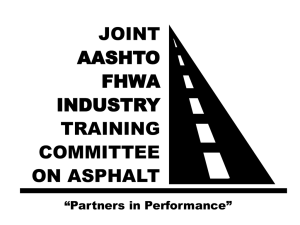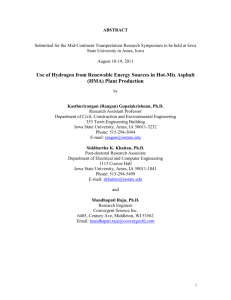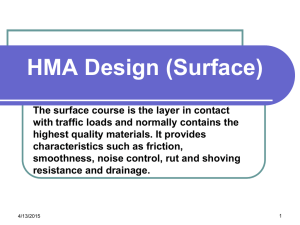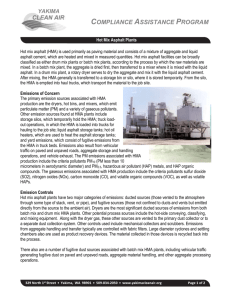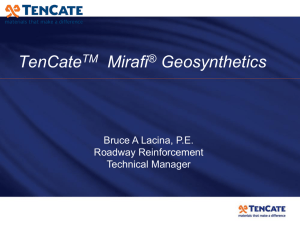tests and evaluations of in-service asphalt trackbeds
advertisement
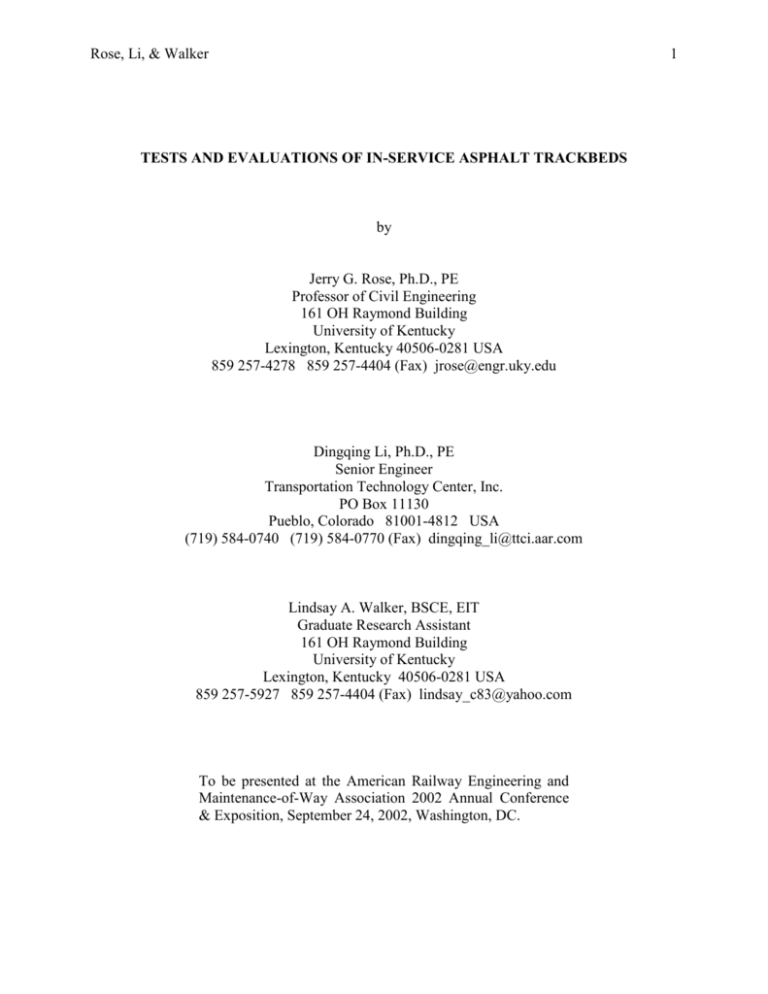
Rose, Li, & Walker 1 TESTS AND EVALUATIONS OF IN-SERVICE ASPHALT TRACKBEDS by Jerry G. Rose, Ph.D., PE Professor of Civil Engineering 161 OH Raymond Building University of Kentucky Lexington, Kentucky 40506-0281 USA 859 257-4278 859 257-4404 (Fax) jrose@engr.uky.edu Dingqing Li, Ph.D., PE Senior Engineer Transportation Technology Center, Inc. PO Box 11130 Pueblo, Colorado 81001-4812 USA (719) 584-0740 (719) 584-0770 (Fax) dingqing_li@ttci.aar.com Lindsay A. Walker, BSCE, EIT Graduate Research Assistant 161 OH Raymond Building University of Kentucky Lexington, Kentucky 40506-0281 USA 859 257-5927 859 257-4404 (Fax) lindsay_c83@yahoo.com To be presented at the American Railway Engineering and Maintenance-of-Way Association 2002 Annual Conference & Exposition, September 24, 2002, Washington, DC. Rose, Li, & Walker TESTS AND EVALUATIONS OF IN-SERVICE ASPHALT TRACKBEDS 2 Rose, Li, & Walker 3 Jerry G. Rose, Dingqing Li, & Lindsay A. Walker During the past twenty years the use of hot mix asphalt (HMA) as a sub-ballast layer within the track structure has steadily increased until it is becoming standard practice in many areas of the United States. This asphalt-bound impermeable layer, typically 5 to 8 in. (125 to 200 mm) thick, forms a superior “hardpan” to protect the underlying roadbed and to support the overlying ballast and track. Long-term performance studies on numerous HMA installations attest to the improved attributes and economic benefits of the HMA layer, particularly on heavy tonnage lines traversing areas of marginal geotechnical engineering characteristics. Previous investigations–involving core drilling, sampling, and characterization of trackbed materials–were conducted on twelve in-service HMA trackbeds. These were widely scattered over six different states and averaged thirteen years of service. The strength and bearing capacity values of the protected roadbed materials remain near optimum, thus assuring adequate support for the track. The HMA layer–protected from temperature extremes, sunlight, and oxidation–maintains mechanical properties essentially unaffected after many years of exposure and loading. The results of these investigations are summarized. More recent studies involve instrumenting several HMA trackbeds with earth pressure cells and displacement transducers to measure trackbed pressures and deflections and to calculate track stiffness (modulus). These tests, conducted in the real time domain train operations, confirm the positive attributes of the HMA layer. Results are presented for several test installations on CSX Transportation heavy tonnage mainlines and for the Transportation Technology Center (Pueblo) low track modulus heavy tonnage test track. For the 115 ton (105 metric ton) loaded hopper cars, track deflections are typically 0.25 in. (6 mm) for wood tie track and 0.05 in. (1.5 mm) for concrete tie track. These equate to dynamic track modulus values of 3000 lb/in/in (20 MPa) and 7500 lb/in/in (50 MPa) respectively. Vertical pressures at the Rose, Li, & Walker 4 ballast/HMA interface are a function of imposed loadings and range up to 17 psi (120 kPa) for 36 ton (33 metric ton) axle loads. Pressures are further reduced to about 5 to 7 psi (35 to 50 kPa) under the HMA layer at the subgrade interface. It is shown that the low trackbed stress level is due in part to the high sheer stress development in the ballast since the HMA layer provides optimum restraint and support for the ballast. The low stress level assures a long fatigue life for the asphalt layer. The results of these investigations and associated relationships which were developed are presented in detail. The use of an asphalt layer within the track structure is appropriate for both the construction of new lines and the rehabilitation of existing lines. The long-term economics are particularly beneficial for special trackworks and poor subgrade/drainage conditions in open track. Key Words: railway, trackbed, asphalt, underlayment, pressure, deflection Rose, Li, & Walker 5 INTRODUCTION During the past twenty years in the United States, the use of hot mix asphalt (HMA) as an underlayment (or sub-ballast) layer within the track structure has steadily grown. It is becoming a standard procedure on heavy tonnage rail lines in certain areas of the U.S., particularly where prevailing subgrade materials and drainage conditions are not compatible with conventional open granular trackbed designs. The HMA layer strengthens trackbed support and waterproofs the underlying roadbed. It also provides a consistently high level of confinement for the overlying ballast and track. These factors become increasingly more significant as axle loads and total tonnages increase on mainlines. For example, the Association of American Railroad statistics (1) reveal that average freight car capacities have steadily increased over the years and presently average 92.7 tons (84 metric tons), double that of 1929. The 100-ton car (91 metric tons) having a gross weight of 263,000-lb (119 metric tons) has been standard for years, but is being rapidly replaced by the 286,000-lb (130 metric tons) car. The 315,000-lb (143 metric ton) car is undergoing testing. Furthermore, in 2000 the U.S. railroads set volume records for ton-miles, tonnage, and intermodal traffic. Revenue ton-miles increased 2.3% over the prior year to 1.47 trillion, a record high, while tonnage jumped to a record high of 1.74 billion. Car loadings, which rose 2.5% in 2000, attained their highest level in three decades, using today’s higher capacity cars. Also hauled were a record 9.2 million high priority, time sensitive intermodal trailers and containers. Obviously today’s U.S. heavy haul tonnage railroads require high performance track structures to minimize maintenance outages and enhance operating conditions. Rose, Li, & Walker 6 TYPICAL ASPHALT UNDERLAYMENT PRACTICES The typical HMA layer is 12 ft (3.7 m) wide and is 5 to 6 in. (125 to 150 mm) thick (2). For unusually poor roadbed support conditions and high impact areas, an 8 in. (200 mm) thickness is used. Thickness of the overlying ballast normally ranges from 8 to 12 in. (200 to 300 mm). HMA is used for new track construction and for rehabilitation/maintenance of existing lines. It has a wide range of applications including open track, special trackwork (switches or turnouts, crossing diamonds, etc.) bridge approaches, tunnels and tunnel approaches, and highway/rail crossings. Figure 1 is a typical cross-sectional view. The common HMA mixture specification is the prevailing dense-graded highway base mix in the area having a maximum aggregate size of 1 to 1.5 in. (25 to 37 mm). Normally the asphalt binder content is increased by 0.5% above that considered optimum for highway applications resulting in a low to medium modulus (plastic) mix having a design air voids of 1 to 3%. It is believed that this slight modification to the typical highway mix will impart the ideal properties to the track structure. This mix is easier to densify to less than 5% in-place air voids assuring adequate strength and an impermeable mat. Rutting of the plastic mix is not a concern in the trackbed since the pressures are applied through the ballast over a wide area. Bleeding and flushing are also non-issues since the wheels do not come in direct contact with the HMA layer and the temperature extremes are minimized in the insulated trackbed environment. HMA TRACKBED STUDIES AT UNIVERSITY OF KENTUCKY Development of asphalt trackbed technology has been ongoing at the University of Kentucky since the early 1980s (3, 4, 5). Most of these endeavors have been supported by CSX Transportation and conducted on CSXT rail lines in the eastern portion of the United States. Rose, Li, & Walker 7 Additional studies have been supported by BNSF Railway in the midwest portion of the U.S. These two railroads account for nearly 50 percent of the Class I railroad industry in the U.S. Trackbed Materials Classifications Recent investigations–involving core drilling, sampling and characterization of trackbed materials–were conducted on twelve in-service HMA trackbeds on CSXT and BNSF revenue lines in six states (6). These HMA trackbeds, averaging 13 years of service, were providing essentially maintenance-free service and were selected to include varying geographical and geological conditions. Of particular interest was determining the types, conditions, and moisture contents of the old roadbed/subgrade materials directly under the HMA mat. The investigations involved a wide variety of substructures–from low-strength (high plasticity) clays to moisture-sensitive silts to higher quality granular materials. The significant finding was that the in-situ moisture contents are very close to laboratory determined optimum values for maximum density of the respective materials. The HMA mat does not appear to be performing as a membrane to collect and trap moisture, thus weakening support. Actually, since the in-situ moisture contents are at or near optimum for maximum density, the strengths and load carrying capacities of the underlying materials remain uniformly high. Furthermore, average moisture contents have remained essentially unchanged, at or near optimum, for the two projects from which previous data was available. For design purposes, it is reasonable to base strength or bearing capacity values at optimum conditions (moisture content and density) for the material under the HMA mat. Using strength or bearing capacity values determined for the soaked condition, common for highway designs, is inappropriate for HMA trackbed designs. The unsoaked, optimum moisture content condition is consistent with inservice trackbed conditions. Rose, Li, & Walker 8 The HMA cores and extracted/recovered asphalt binders were extensively evaluated at the National Center for Asphalt Technology at Auburn University with assistance from the Asphalt Institute. Selected samples were forwarded to the Western Research Institute for indepth tests and evaluations. The primary purpose was to determine if any significant weathering or deterioration of the HMA (insulated from sunlight and temperature extremes) was occurring in the trackbed environment, which could adversely affect long-term performance. A variety of HMA mixture compositions and mat thicknesses were evaluated. It was concluded that the various asphalt binders and HMA mixes did not exhibit any indication of excessive hardening (brittleness), weathering, or deterioration even after many years in the trackbed environment. This is primarily due to the insulative effects of the overlying ballast. This protects the HMA from sunlight and excessive temperature extremes, which significantly reduces oxidation and hardening of the asphalt binder. The mat remains slightly flexible, which contributes to a long fatigue life for the HMA layer. There is no indication that the HMA mats are experiencing any loss of fatigue life. These findings were further confirmed by extensive chemical analyses of the recovered asphalt binders, which were conducted at the Western Research Institute. It has been observed that mixes specifically designed to be more viscous (plastic) are conducive to the angular ballast particles slightly penetrating or imbedding into the top surface of the asphalt mat. This increases the interfacial shear strength and improves overall structural value of the track structure. Furthermore, the uniformly high level of support provided by the HMA mat maintains a high degree of ballast compaction which results in increased modulus, reduced wear, and increased life of the ballast. This is a primary contributor to the extended excellent track geometry indicators provided by the HMA mat and confined ballast layer. The combined supports provided by the HMA mat and the confined ballast layer are believed to be Rose, Li, & Walker 9 primary contributors to the excellent track geometry indicators routinely measured over long periods of time. Trackbed Pressure/Stress Measurements Trackbed pressure (stress) measurements have been obtained at prevailing speeds under heavy tonnage railroad loadings. Pressure measurements were recorded using hydraulic type (Geokon model 3500-2) earth pressure cells (Figure 2). These are imbedded in the track structure above and below the HMA mat. The location of one of these on the mat can also be seen in Figure 2. Peak pressures occur directly below the tie/rail interface. Figure 3 is a typical plot of the pressures exerted on top of the HMA mat for an empty coal train. Vertical pressures imposed by typical 286,000 lb (130 metric ton) locomotives range from 13 to 17 psi (90 to 120 kPa) on top of the HMA mat. The average locomotive wheel load is 35,000 lb (16 metric tons). Pressures are reduced to 2 to 4 psi (15 to 30 kPa) under the 62,000 lb (28 metric ton) empty cars which have an average wheel load of 8000 lb (3.5 metric tons). The beam action of the track, which distributes the concentrated wheel loadings over several ties and the confined, high modulus ballast layer, serve to effectively reduce the heavy wheel loadings. By comparison, a 180 lb (82 kg) person will exert about 6 psi (40 kPa) pressure while standing on a level surface. Furthermore, typical tire pressures imposed on highway asphalt surfaces under loaded trucks range from 100 psi (700 kPa) to over 200 psi (1400 kPa) depending on the magnitude of loading and tire configurations. The effect of flat wheels on pressures exerted within the track structure has also been evaluated. Figure 4 is a fully loaded auto train. Note that the pressure at the top of the HMA is increased by three orders of magnitude. Rose, Li, & Walker 10 It can be concluded that trackbed vertical stress levels on top of the HMA mat under heavy tonnage railroad loadings are very low and only a fraction of those imposed by highpressure truck tires on highway pavements. The HMA mat should have an extremely long fatigue life at the load-induced pressure levels existing in the trackbed environment. Trackbed Deflection Measurements Dynamic track deflections have been recorded in conjunction with the pressure measurements using linear variable displacement transducers referenced to a fixed datum (Figure 5). Rail deflections under the 286,000 lb (130 metric ton) locomotives and loaded cars average 0.25 in. (6 mm) for wood tie track and around 0.05 in. (1.5 mm) for concrete tie track (Figure 6). These are considered optimum for both track types. Calculated dynamic track modulus (stiffness) values are in the 2500 lb/in/in (17 MPa) range for wood tie track and around 7500 lb/in/in (52 MPa) for concrete tie track. These are also considered optimum. The concrete tie track deflects much less than the wood tie track and is thus much stiffer. This increases pressure values within the ballast. The ballast must be properly supported from below so it can develop high shear strength to reduce the higher than normal imposed loading pressures. The high modulus HMA mat provides increased support and confinement for the ballast in concrete tie track. Temperatures at the ballast/HMA layer have been periodically monitored using thermisters which are an integral part of the pressure cells. Figure 7 shows the relationship between temperature and time during the year measurements were taken. Since the HMA is insulated from the atmosphere by the overlying ballast and track, the temperature extremes in summer and winter are minimized. The maximum temperature recorded in the summer was 75ºF (24ºC) and the minimum in the winter was 36ºF (2ºC). Pavements exposed to the atmosphere Rose, Li, & Walker 11 and direct sunlight will typically experience temperature extremes of 120ºF (50ºC) to 0ºF (-17ºC) in the Kentucky climate. HMA TRACKBED STUDIES AT TRANSPORTATION TECHNOLOGY CENTER The Association of American Railroads subsidiary, Transportation Technology Center, Inc. (TTCI), has been involved with additional measurements and evaluations of HMA underlayment trackbeds (7). Explanations of these recent research efforts are detailed in the following sections. Introduction and Background One of the main causes for track geometry deterioration is the deterioration of soft subgrade support. Without remedy, a subgrade of fine-grained soils will develop excessive deformation under heavy axle loads, which in turn will lead to excessive track maintenance costs. Geometry deterioration due to soft subgrade support will worsen with an increase in train axle loads or operating speeds. In recent years, the effects of heavy axle loads upon track substructure performance have been studied at the High Tonnage Loop (HTL) at the Transportation Technology Center near Pueblo, Colorado. It was found that a track with track modulus of 2,000 lbs/in/in (13.8 MPa) or less (i.e., a conventional 18-in. (450-mm) granular layer over a soft clayey subgrade) required frequent surfacing maintenance under 39-ton (36-metric ton) axle loads. Therefore, various remedies aimed at limiting excessive subgrade deformation have been tested and their effectiveness judged. The soft subgrade test track was built in the 2.7-mile (4.3 km) HTL. The soft subgrade was built by excavating into the native subgrade soil (silty sand). A 700-ft (213-m) long, 12-ft (3.6-m) wide, and 5-ft (1.5-m) deep trench was then backfilled with Vicksburg (Buckshot) clay. To prevent the loss of clay moisture over time, the sides and bottom of the clay subgrade are Rose, Li, & Walker 12 lined with a plastic membrane. Since its installation, this subgrade has remained at high moisture content (approximately 33 percent). To date, several methods to remedy soft subgrade deformation have been tested, including an increased granular layer thickness, geocell reinforcement, and the application of hot-mix asphalt (HMA) underlayments. Use of a 27-in. (685-mm) granular layer thickness 15in. ((375-mm) subballast) improved track performance, but did not prevent a rapid geometry degradation following a heavy rainfall due to water building up under and in the thick and dense subballast layer. Use of the granular layer with geocell (24-in. (600 mm) of total thickness) improved track performance, with no surfacing maintenance needed in 200 MGT (180 MGt) of traffic. The current HMA underlayment test started in the summer of 1999. Design and Construction of HMA Underlayments at TTCI In the summer of 1999, two HMA underlayments were placed as a course under the ballast but above the soft subgrade. Each segment is about 350 ft (107 m) long. One segment has a 4-in. (100-mm) HMA, and the other has a 8-in. (200-mm) HMA. Figure 8 illustrates the longitudinal cross section of these two segments. For the entire test section, a 4-in. (100-mm) subballast layer was used between the subgrade and the two HMA underlayments. At construction, the ballast thickness above the HMA was 12 in. (300 mm) over the 4-in. (100-mm) HMA, but was 8-in. (200-mm) over the 8-in. (200-mm) HMA. For both segments, the total granular/HMA thickness was therefore 20 in. (500 mm). The asphalt mix design was based on the guidelines recommended by the Asphalt Institute (2). Table 1 gives the recommended and the actual compositions for the HMA mix, which is essentially similar to a dense-graded, low voids base course for highway construction. Rose, Li, & Walker 13 The required HMA strength and the ability in reducing the access of water into the subgrade were achieved by meeting the Marshall design criteria. Table 2 lists the recommended design criteria as well as the actual test results for the mix composition as defined in Table 1. During the construction, the HMA placement was done in one lift for the 4-in. (100-mm) HMA, but in two lifts for the 8-in. (200-mm) HMA. To achieve the desired HMA density listed in Table 2, a steel-wheeled, vibratory roller was used to compact the HMA layer while the mix was still between 185 to 300ºF (85 to 150ºC). Following compaction, a nuclear density gage was used to obtain the final in-situ HMA density results. In addition, a number of HMA core samples were obtained for further laboratory testing. Test Results of Track Performance at TTCI This test is the first to apply HMA underlayment over a soft subgrade under 40 ton (36 metric ton) axle loads. The use of HMA underlayment is intended to reduce traffic load induced stresses to the subgrade and to provide a waterproof layer over the underlying soil. Since its installation, the performance of this test track has been evaluated in terms of track geometry degradation with traffic as well as the amounts of track modulus increase and subgrade stress reduction compared to conventional granular layer construction. Figure 9 gives the track modulus test results obtained at 92 MGT (83 MGt) and the subgrade stress results under a static wheel load of 40,000 lbs (18 metric tons). As shown, the average modulus values for the two HMA segments are 2,800 lb/in/in (20 MPa) and 3,300 lb/in/in (23 MPa) for the fully consolidated ballast (increased from 2600 and 2800 lb/in/in (18 and 19 MPa)), respectively, at 0 MGT (0 MGt). Obviously, the HMA underlayment application significantly increased track modulus from the 18-in. (450-mm) granular track with an average track modulus of 2000 lb/in/in (14 MPa). As a result, the measured subgrade stresses were lower for the asphalt trackbeds than for the 18-in. (450-mm) granular track. Under 40 kip (18 metric Rose, Li, & Walker 14 ton) static wheel load, only 7 to 8 psi (50 to 55 kPa) of subgrade stress was generated under the HMA underlayments, compared to 12 psi (83 kPa) under the 18-in. (450-mm) granular track structure. To show how stresses induced by wheel loads are reduced from the HMA to the subgrade, Figure 10 shows the dynamic stress results under an actual train operation at 40 mph (64 km/hr) measured on the 8-in. (200 mm) HMA surface as well as on the subgrade surface. As illustrated, use of a 8-in. (200 mm) HMA underlayment reduced the subgrade stress by approximately one half. Figure 11 shows the results of average track settlement as a function of traffic for both the segments. As illustrated, after the initial higher rate due to early ballast consolidation, the settlements became gradual, characteristic of typical and normal track deformation. After almost 100 MGT (91 MGt), about 1.5 in. (37 mm) of total settlement was accumulated for the 4-in. (100 mm) HMA segment, while about 1.3 in. (33 mm) of total settlement was observed for the 8-in. (200-mm) HMA segment. Nevertheless, the settlements (mainly due to ballast deformation) have been uniform along and across the test track. No geometry maintenance has been required to date. Another benefit of using HMA underlayment beneath ballast is insulating the asphalt layer from the air. This should keep the asphalt less susceptible (compared to highway construction) to the oxidation and temperature effects, thus leading to longer asphalt life without weathering and cracking. In Figure 12, temperature recordings were made over a span of about one year for both the HMA underlayment and the air. As shown, HMA temperature experienced much less variation than air temperature. Rose, Li, & Walker 15 FINDINGS AND CONCLUSIONS Use of HMA as an underlayment within the track structure is steadily growing in the U.S., particularly for heavy-haul applications. Long-term performances of HMA trackbeds have been outstanding. Peak dynamic pressures within the track structure occur directly under the tie/rail interface. Peak dynamic pressures range from 13 to 17 psi (90 to 120 kPa) on top of the HMA mat under 286,000 lb (130 metric ton) locomotives and heavily loaded cars—only two to three times greater in magnitude than the pressure exerted by an average size person standing on the HMA. Peak dynamic vertical pressures under similar loading are further reduced to 5 to 7 psi (35 to 50 kPa) under the HMA layer at the subgrade interface. Dynamic track deflections for HMA trackbeds under 286,000 lb (130 metric ton) locomotives average 0.25 in. (6 mm) for wood tie track and 0.05 in. (1.5 mm) for concrete tie track. These are considered optimum. Dynamic track modulus (stiffness) values consistently average 2900 lb/in/in (20 MPa) for wood tie track and 7200 lb/in/in (50 MPa) for concrete tie track. These are considered optimum. In-track test measurements on HMA underlayment trackbeds obtained for CSXT's heavyhaul revenue lines and at TTCI's heavy-haul research test facility are consistent with respect to magnitude and time. Moisture contents of old roadbeds/subballasts/subgrades under the HMA mat remain at or near optimum after many years assuring optimum support for the HMA mat. This attests to the waterproofing attributes provided by the HMA mat. An equally important attribute of the Rose, Li, & Walker 16 HMA mat is the confinement it provides for the ballast so that the ballast can develop maximum shear strength and compactness. The HMA mat in the insulated trackbed environment undergoes minimum variation in temperature extremes throughout the year and it is not exposed to direct sunlight. The modulus (stiffness) is reasonably uniform throughout the year and weathering (oxidation) of the HMA is minimal compared to highway applications. The combination of low induced stress levels, minimal temperature changes and minimal weathering in the trackbed environment assures a very long fatigue life for the HMA mat as compared to highway HMA applications. ACKNOWLEDGMENTS The research reported herein was supported financially by CSX Transportation, the Association of American Railroads, the Federal Railroad Administration, and the Asphalt Institute. Technical advice received from M.J. Hensley, retired Chief Engineer of the Asphalt Institute, greatly benefited the research. Also, the efforts of three University of Kentucky Civil Engineering graduate students–Bennett A. McElroy, Daniel M. Durrett, and William B. Long–during the early phases of the project are gratefully acknowledged. REFERENCES 1. Association of American Railroads (2001) Railroad Facts, 2001 Edition, 84 p. 2. Asphalt Institute (1998) HMA Trackbeds–Hot Mix Asphalt for Quality Railroad and Transit Trackbeds, Informational Series 137, 10 p. Rose, Li, & Walker 17 3. Rose, J.G. & Hensley, M.J. (1991) Performance of Hot Mix Asphalt Railway Trackbeds. Transportation Research Record 1300, Transportation Research Board, pp. 35-43. 4. Rose, J.G. (1998) Long-Term Performances, Tests and Evaluations of Asphalt Trackbeds. Proceedings of the 1998 AREMA Technical Conference, Chicago, September, 27 p. 5. Rose, J.G. (2000) Asphalt Trackbeds: Selection, Design, Installation Practices, LongTerm Performances & Material Properties. Proceedings of Railway Engineering-2000 3rd International Conference and Exhibition, London, July, 12 p. 6. Rose, J.G., Brown, E.R. & Osborne, M.L. (2000) Asphalt Trackbed Technology Development: The First 20 Years. Transportation Research Record 1713, Transportation Research Board, pp. 1-9. 7. Li, D., Rose, J. & LoPresti, J. (2001) Test of Hot-Mix Asphalt Trackbed Over Soft Subgrade Under Heavy Axle Loads. Technology Digest 01-009, Transportation Technology Center, Inc., April, 4 p. Rose, Li, & Walker LIST OF TABLES TABLE 1. Composition of Dense-Graded HMA Mix TABLE 2. Marshall Mix Design Criteria for HMA Underlayment 18 Rose, Li, & Walker 19 TABLE 1. Composition of Dense-Graded HMA Mix Sieve size 1.5 inch ¾ inch 3/8 inch No. 4 No. 8 No. 16 No. 30 No. 50 No. 200 37.5 mm 19 mm 9.5 mm 4.75 mm 2.36 mm 1.18 mm 0.60 mm 300 µm 75 µm Asphalt Amount finer, weight % Recommended Actual 100 100 70 - 98 76 44 - 76 52 30 - 58 41 21 - 45 30 14 - 35 23 8 - 25 17 5 - 20 11 2-6 4.5 3.5 - 6.5 6.4 Rose, Li, & Walker 20 TABLE 2. Marshall Mix Design Criteria for HMA Underlayment Property Required Range Compaction 50 blows Stability lbs (N) Minimum 750 (3300) Flow inch (mm) 0.15 – 0.25 (3.8 - 6.4) Percent air voids 1 - 3% Voids filled w/asphalt 80 - 90% In-place density* 92 - 98% *Maximum density = 151 ptc (2424 kg/m³) ** Average nuclear density test results Actual Test Results 50 blows 1730 (7700) 0.24 (6.1) 2% 86% 94%** Rose, Li, & Walker 21 LIST OF FIGURES Figure 1.Typical Cross-section Figure 2. Pressure Cells Figure 3. Empty Coal Train at Conway Figure 4. Flat Wheel on a Loaded Auto Train at Conway Figure 5. LVDT Configuration Figure 6. Deflection under Loaded Coal Train Figure 7. Conway Top of HMA Temperature vs. Time Figure 8. Longitudinal Cross Section of HMA Test Track Figure 9. Test Results in Track Modulus (consolidated ballast) and Subgrade Stress (under 40 kip (18 metric ton) static wheel load) Figure 10. Reduction of Dynamic Stresses from 8-in. (200 mm) HMA to Subgrade under 39 ton (35 metric ton) Axle Cars Figure 11. Track Settlement as a Function of Traffic Figure 12. HMA Temperature vs. Air Temperature Rose, Li, & Walker 22 Figure 1: Typical Cross-section Rose, Li, & Walker 23 Figure 2: Pressure Cells Rose, Li, & Walker 24 Rose, Li, & Walker 25 Rose, Li, & Walker 26 Rose, Li, & Walker 27 Rose, Li, & Walker 28 Rose, Li, & Walker 29 Rose, Li, & Walker 30 Rose, Li, & Walker 31
